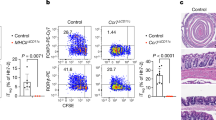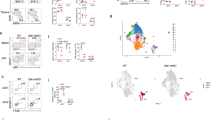Abstract
Immunoglobulin-A has an irreplaceable role in the mucosal defence against infectious microbes1,2,3,4,5,6. In human and mouse, IgA-producing plasma cells comprise ∼20% of total plasma cells of peripheral lymphoid tissues, whereas more than 80% of plasma cells produce IgA in mucosa-associated lymphoid tissues (MALT)1,2,3,4,5,6. One of the most biologically important and long-standing questions in immunology is why this ‘biased’ IgA synthesis takes place in the MALT but not other lymphoid organs. Here we show that IgA class-switch recombination (CSR) is impaired in inducible-nitric-oxide-synthase-deficient (iNOS-/-; gene also called Nos2) mice. iNOS regulates the T-cell-dependent IgA CSR through expression of transforming growth factor-β receptor, and the T-cell-independent IgA CSR through production of a proliferation-inducing ligand (APRIL, also called Tnfsf13) and a B-cell-activating factor of the tumour necrosis factor (TNF) family (BAFF, also called Tnfsf13b). Notably, iNOS is preferentially expressed in MALT dendritic cells in response to the recognition of commensal bacteria by toll-like receptor. Furthermore, adoptive transfer of iNOS+ dendritic cells rescues IgA production in iNOS-/- mice. Further analysis revealed that the MALT dendritic cells are a TNF-α/iNOS-producing dendritic-cell subset, originally identified in mice infected with Listeria monocytogenes7,8. The presence of a naturally occurring TNF-α/iNOS-producing dendritic-cell subset may explain the predominance of IgA production in the MALT, critical for gut homeostasis.
This is a preview of subscription content, access via your institution
Access options
Subscribe to this journal
Receive 51 print issues and online access
$199.00 per year
only $3.90 per issue
Buy this article
- Purchase on Springer Link
- Instant access to full article PDF
Prices may be subject to local taxes which are calculated during checkout




Similar content being viewed by others
References
Brandtzaeg, P. et al. Regional specialization in the mucosal immune system: what happens in the microcompartments? Immunol. Today 20, 141–151 (1999)
van Egmond, M. et al. IgA and the IgA Fc receptor. Trends Immunol. 22, 205–211 (2001)
Mostov, K. E. Transepithelial transport of immunoglobulins. Annu. Rev. Immunol. 12, 63–84 (1994)
Matsunaga, T. & Rahman, A. What brought the adaptive immune system to vertebrates?—The jaw hypothesis and the seahorse. Immunol. Rev. 166, 177–186 (1998)
Fagarasan, S. & Honjo, T. Intestinal IgA synthesis: regulation of front-line body defences. Nature Rev. Immunol. 3, 63–72 (2003)
Suzuki, K. et al. Aberrant expansion of segmented filamentous bacteria in IgA-deficient gut. Proc. Natl Acad. Sci. USA 101, 1981–1986 (2004)
Serbina, N. V., Salazar-Mather, T. P., Biron, C. A., Kuziel, W. A. & Pamer, E. G. TNF/iNOS-producing dendritic cells mediate innate immune defense against bacterial infection. Immunity 19, 59–70 (2003)
Serbina, N. V. & Pamer, E. G. Monocyte emigration from bone marrow during bacterial infection requires signals mediated by chemokine receptor CCR2. Nature Immunol. 7, 311–317 (2006)
Macpherson, A. J. & Uhr, T. Induction of protective IgA by intestinal dendritic cells carrying commensal bacteria. Science 303, 1662–1665 (2004)
Macpherson, A. J. et al. A primitive T cell-independent mechanism of intestinal mucosal IgA responses to commensal bacteria. Science 288, 2222–2226 (2000)
Litinskiy, M. B. et al. DCs induce CD40-independent immunoglobulin class switching through BLyS and APRIL. Nature Immunol. 3, 822–829 (2002)
Castigli, E. et al. TACI and BAFF-R mediate isotype switching in B cells. J. Exp. Med. 201, 35–39 (2005)
Mestecky, J. & McGhee, J. R. Immunoglobulin A (IgA): molecular and cellular interactions involved in IgA biosynthesis and immune response. Adv. Immunol. 40, 153–245 (1987)
Fagarasan, S., Kinoshita, K., Muramatsu, M., Ikuta, K. & Honjo, T. In situ class switching and differentiation to IgA-producing cells in the gut lamina propria. Nature 413, 639–643 (2001)
Bogdan, C. Nitric oxide and the immune response. Nature Immunol. 2, 907–916 (2001)
Fujihashi, K. et al. γ/δ T cell-deficient mice have impaired mucosal immunoglobulin A responses. J. Exp. Med. 183, 1929–1935 (1996)
Shimada, S.-I. et al. Generation of polymeric immunoglobulin receptor-deficient mouse with marked reduction of secretory IgA. J. Immunol. 163, 5367–5373 (1999)
Muramatsu, M. et al. Class switch recombination and hypermutation require activation-induced cytidine deaminase (AID), a potential RNA editing enzyme. Cell 102, 553–563 (2000)
Cazac, B. B. & Roes, J. TGF-β receptor controls B cell responsiveness and induction of IgA in vivo. Immunity 13, 443–451 (2000)
Borsutzky, S., Cazac, B. B., Roes, J. & Guzman, C. A. TGF-β receptor signaling is critical for mucosal IgA responses. J. Immunol. 173, 3305–3309 (2004)
Park, S. R., Lee, J. H. & Kim, P. H. Smad3 and Smad4 mediate transforming growth factor-β1-induced IgA expression in murine B lymphocytes. Eur. J. Immunol. 31, 1706–1715 (2001)
Fainaru, O. et al. Runx3 regulates mouse TGF-β-mediated dendritic cell function and its absence results in airway inflammation. EMBO J. 23, 969–979 (2004)
Castigli, E. et al. Impaired IgA class switching in APRIL-deficient mice. Proc. Natl Acad. Sci. USA 101, 3903–3908 (2004)
von Bulow, G.-U., van Deursen, J. M. & Bram, R. J. Regulation of the T-independent humoral response by TACI. Immunity 14, 573–582 (2001)
He, B., Raab-Traub, N., Casali, P. & Cerutti, A. EBV-encoded latent membrane protein 1 cooperates with BAFF/BLyS and APRIL to induce T cell-independent Ig heavy chain class switching. J. Immunol. 171, 5215–5224 (2003)
Iwata, M. et al. Retinoic acid imprints gut-homing specificity on T cells. Immunity 21, 527–538 (2004)
Mora, J. R. et al. Generation of gut-homing IgA-secreting B cells by intestinal dendritic cells. Science 314, 1157–1160 (2006)
Rakoff-Nahoum, S., Paglino, J., Eslami-Varzaneh, F., Edberg, S. & Medzhitov, R. Recognition of commensal microflora by toll-like receptors is required for intestinal homeostasis. Cell 118, 229–241 (2004)
Rescigno, M. et al. Dendritic cells express tight junction proteins and penetrate gut epithelial monolayers to sample bacteria. Nature Immunol. 2, 361–367 (2001)
Niess, J. H. et al. CX3CR1-mediated dendritic cell access to the intestinal lumen and bacterial clearance. Science 307, 254–258 (2005)
Nishiyama, Y. et al. Homeostatic regulation of intestinal villous epithelia by B lymphocytes. J. Immunol. 168, 2626–2633 (2002)
Adachi, O. et al. Targeted disruption of the MyD88 gene results in loss of IL-1- and IL-18-mediated function. Immunity 9, 143–150 (1998)
Kitamura, D., Roes, J., Kuhn, R. & Rajewsky, K. A B cell-deficient mouse by targeted disruption of the membrane exon of the immunoglobulin μ chain gene. Nature 350, 423–426 (1991)
Noguchi, H., Matsushita, M., Okitsu, T. & Matsui, H. A new cell-permeable peptide allows successful allogeneic islet transplantation in mice. Nature Med. 10, 305–309 (2004)
Acknowledgements
We thank K. Onodera for animal care; K. Yamashita for experimental support; K. Honda, M. Muramatsu and M. Miyasaka for discussions; M. Nanno for BALB/c germ-free mice; T. Tsubata for B6.μMt mice; and K. Takatsu for monoclonal antibody H-7. This work was supported by Yakult Bio-Science Foundation (to T.O.), a Sasakawa Scientific Research Grant from The Japan Science Society (to H. Tezuka), a Grant-in-Aid for Scientific Research on Priority Areas from the Ministry of Education, Science, Sports and Culture of Japan (T.O.), and a Grant-in-Aid for Young Scientists (B) (to H. Tezuka.).
Author information
Authors and Affiliations
Corresponding author
Ethics declarations
Competing interests
Reprints and permissions information is available at www.nature.com/reprints. The authors declare no competing financial interests.
Supplementary information
Supplementary Figures
This file contains Supplementary Figures 1-6 with Legends. These provide data that corroborate the main findings of the text. (PDF 1097 kb)
Rights and permissions
About this article
Cite this article
Tezuka, H., Abe, Y., Iwata, M. et al. Regulation of IgA production by naturally occurring TNF/iNOS-producing dendritic cells. Nature 448, 929–933 (2007). https://doi.org/10.1038/nature06033
Received:
Accepted:
Issue Date:
DOI: https://doi.org/10.1038/nature06033
This article is cited by
-
Single-cell analysis of gastric signet ring cell carcinoma reveals cytological and immune microenvironment features
Nature Communications (2023)
-
Intestinal Peyer’s Patches: Structure, Function, and In Vitro Modeling
Tissue Engineering and Regenerative Medicine (2023)
-
TREM-2 mediates dendritic cell–induced NO to suppress Th17 activation and ameliorate chronic kidney diseases
Journal of Molecular Medicine (2022)
-
αvβ8 integrin-expression by BATF3-dependent dendritic cells facilitates early IgA responses to Rotavirus
Mucosal Immunology (2021)
-
The association of tumor necrosis factor superfamily 13 with recurrence of immunoglobulin A nephropathy in living related kidney transplantation
BMC Nephrology (2019)
Comments
By submitting a comment you agree to abide by our Terms and Community Guidelines. If you find something abusive or that does not comply with our terms or guidelines please flag it as inappropriate.



